The Cutting Boards Market is estimated to be valued at USD 3.7 billion in 2025 and is projected to reach USD 7.1 billion by 2035, registering a compound annual growth rate (CAGR) of 6.6% over the forecast period.
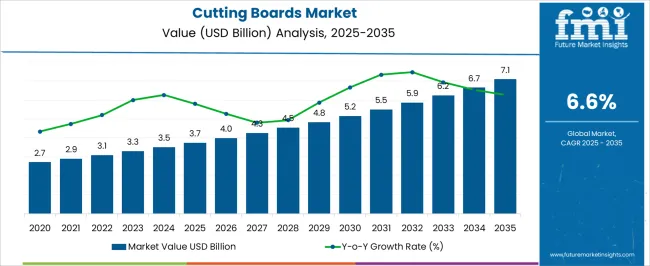
| Metric | Value |
|---|---|
| Cutting Boards Market Estimated Value in (2025 E) | USD 3.7 billion |
| Cutting Boards Market Forecast Value in (2035 F) | USD 7.1 billion |
| Forecast CAGR (2025 to 2035) | 6.6% |
The cutting boards market is experiencing consistent growth as evolving food safety regulations, changing consumer cooking habits, and increased demand for durable kitchen tools continue to shape product development and purchasing behavior. A notable shift toward antibacterial surfaces and easy-to-clean materials has driven innovation in design and material selection, especially in urban and semi-urban households where convenience and hygiene are prioritized.
The growing emphasis on home cooking, fueled by lifestyle changes and health consciousness, is contributing to the rising sales volume in household kitchens. In parallel, retail modernization and the rapid expansion of organized sales channels have enhanced product visibility and customer engagement, supporting wider product penetration across various regions.
Sustainability considerations are also influencing buying preferences, with eco-conscious consumers gravitating toward long-lasting and recyclable cutting board options As manufacturers invest in ergonomic designs and antimicrobial surface technologies, the market is expected to evolve into a blend of functionality, safety, and visual appeal, supported by consistent consumer education and promotional activity in retail spaces.
The market is segmented by Material Type, End User, and Sales Channel and region. By Material Type, the market is divided into Plastic, Wood, Metal, and Others. In terms of End User, the market is classified into Household, Industrial, and Commercial. Based on Sales Channel, the market is segmented into Supermarkets/Hypermarkets, Specialty Stores, Online Stores, and Others. Regionally, the market is classified into North America, Latin America, Western Europe, Eastern Europe, Balkan & Baltic Countries, Russia & Belarus, Central Asia, East Asia, South Asia & Pacific, and the Middle East & Africa.
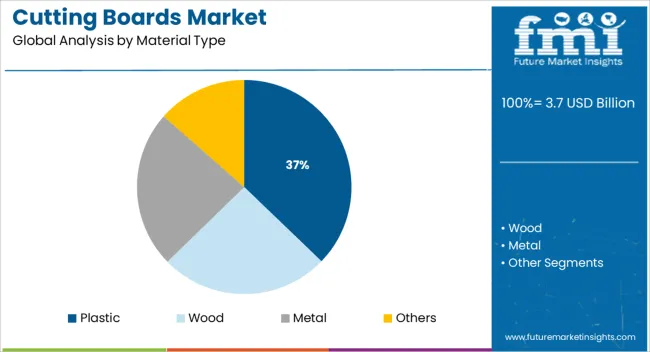
Plastic material type is projected to account for 37.2% of the total revenue share in the cutting boards market in 2025, making it the most dominant material segment. This leading position is supported by the material’s resistance to moisture, ease of cleaning, and compatibility with modern food safety standards. Plastic cutting boards have been preferred in both domestic and semi-commercial settings due to their lightweight structure and suitability for dishwasher cleaning, which aligns well with consumer hygiene concerns.
The non-porous nature of plastic allows it to resist bacteria absorption, making it a safer option for raw meat and seafood handling. Additionally, the availability of BPA-free and antimicrobial variants has expanded plastic’s appeal among health-conscious buyers.
Cost-effectiveness and color-coded designs that help prevent cross-contamination have further reinforced the segment’s growth As food safety awareness and regulatory compliance continue to rise, plastic cutting boards are expected to remain a primary choice for users seeking practicality and hygiene in their food preparation routines.
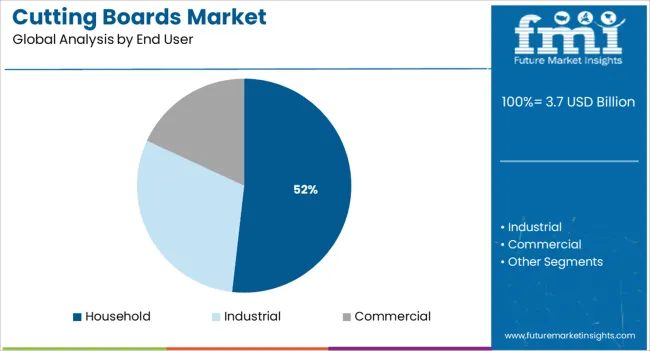
The household end user segment is expected to contribute 51.8% of the cutting boards market revenue in 2025, marking its status as the most significant user base. Growth in this segment is being influenced by a noticeable rise in home-based cooking, meal prepping, and kitchen experimentation, particularly among younger and urban demographics. The increasing popularity of cooking content across social media platforms has fostered greater interest in high-quality kitchen tools, including cutting boards.
Households have shown a preference for aesthetically pleasing yet functional boards that combine ease of use with long-term durability. The introduction of modular cutting board sets designed for different food categories has further supported adoption in domestic kitchens.
Rising disposable incomes and a growing focus on kitchen hygiene have contributed to more frequent replacements and upgrades of basic kitchenware As households seek tools that align with their cooking habits and kitchen aesthetics, demand for reliable and safe cutting boards is expected to remain robust.
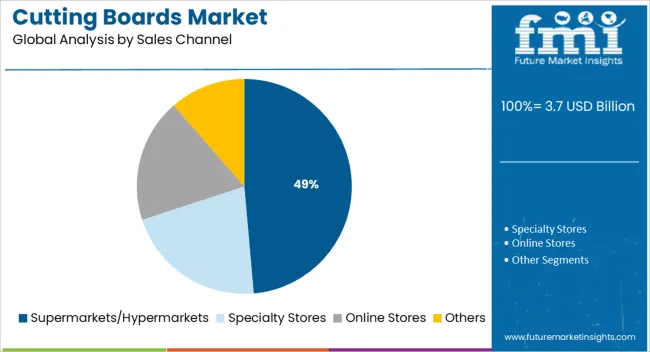
Supermarkets and hypermarkets are anticipated to capture 48.6% of the total revenue share in the cutting boards market in 2025, underscoring their role as the leading sales channel. The segment’s dominance is being driven by high product visibility, convenience in purchase, and consumer trust associated with organized retail environments. Supermarkets and hypermarkets offer a wide range of cutting boards across various price points, materials, and brands, allowing consumers to compare options in-store.
The increasing frequency of bundled kitchenware promotions and in-store demonstrations has supported greater engagement and impulse buying behavior. Retailers have also capitalized on shelf space optimization and promotional signage to influence consumer purchasing decisions.
Stronger supply chain logistics and widespread availability across urban and suburban areas have made these outlets preferred destinations for kitchen essentials As consumer footfall in physical retail stores continues to remain strong, especially in developing markets, supermarkets and hypermarkets are expected to maintain their lead in driving sales of cutting boards.
This halted the sales of cutting boards, as there was no demand. The domestic demand for cutting boards was unchanged, but domestic market is limited in comparison to the big players in food and hospitality sector.
Along with falling sales and low demands of cutting boards, COVID-19 made people aware of good hygiene and healthy lifestyle. The awareness led to increased use of boards made of sturdy and bacteria resistant, easy-to-clean material like glass, metal or marble.
The colour coding of cutting boards in another technique to prevent contamination and be safe, but there are chances that bacteria might find their way in the food. This change in preference led to decrease in plastic and wooden cutting boards demand, but increased demand for metal and marble boards, despite their high costs. These changes in trends and reduced demand are restraining the cutting board market.
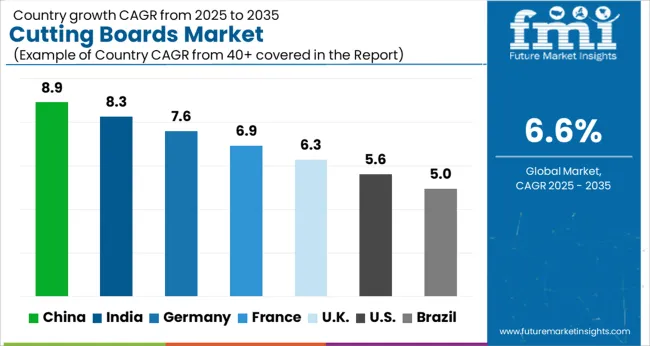
Despite increase in demand of cutting boards made of glass, steel or metal all around the world due to their safety and hygienic properties, Japanese people and restaurants are still sticking to authentic, cultural wooden boards.
Many Japanese chefs say that wooden cutting boards help in development of proper cutting technique and they also keep the blade safe and intact. They use the traditional wooden boards to ensure consistent performance and quality while preparing dishes.
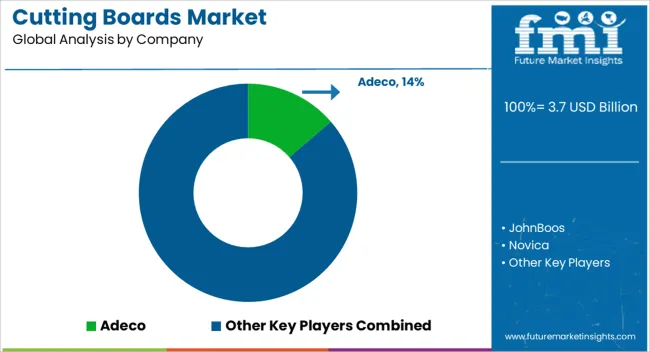
Some key players in the Cutting Boards market are Adeco, Novica, BergHOFF, Zeller Present, Madeira, Catskill Craftsman, John Boos, Ukinox, ETAC, Vigo, MR Direct, Picnic Time, Mario Batali and Totally Bamboo and others.
These companies are providing number of baby care products ranging from shampoos to baby wipes. They are likely to contribute most to the Cutting Boards Market during forecast period.
| Attribute | Details |
|---|---|
| Growth Rate | CAGR of ~6.6% from 2025 to 2035 |
| Base year for estimation | 2024 |
| Historical Data Available for | 2020 to 2024 |
| Forecast Period | 2025 to 2035 |
| Quantitative units | Revenue in USD Billion, volume in Units, and CAGR from 2025 to 2035 |
| Report coverage | Revenue forecast, volume forecast, company ranking, competitive landscape, growth factors, and trends, pricing analysis |
| Segments covered | Material Type, End User, Sales, Region |
| Country scope | USA, Canada, Mexico, Germany, UK, France, Italy, Spain, Russia, India, Thailand, China, India, Japan, Australia, Brazil, Argentina, Colombia, Saudi Arabia, UAE, South Africa |
| Key Companies Profiled | Adeco; Novica; BergHOFF; Zeller Present; Madeira; Catskill Craftsman; John Boos; Ukinox; ETAC; MR Direct; Vigo; Picnic Time; Mario Batali and Totally Bamboo.; Others |
| Customization scope | Free report customization (equivalent to up to 8 analysts working days) with purchase. Addition or alteration to country, regional & segment scope. |
| Pricing and purchase options | Avail customized purchase options to meet your exact research needs. |
The global cutting boards market is estimated to be valued at USD 3.7 billion in 2025.
The market size for the cutting boards market is projected to reach USD 7.1 billion by 2035.
The cutting boards market is expected to grow at a 6.6% CAGR between 2025 and 2035.
The key product types in cutting boards market are plastic, wood, metal and others.
In terms of end user, household segment to command 51.8% share in the cutting boards market in 2025.






Full Research Suite comprises of:
Market outlook & trends analysis
Interviews & case studies
Strategic recommendations
Vendor profiles & capabilities analysis
5-year forecasts
8 regions and 60+ country-level data splits
Market segment data splits
12 months of continuous data updates
DELIVERED AS:
PDF EXCEL ONLINE
Cutting Tool Packaging Market Size and Share Forecast Outlook 2025 to 2035
Cutting and Bending Machine Market Size and Share Forecast Outlook 2025 to 2035
Cutting Balloons Market Insights – Growth, Demand & Forecast 2025 to 2035
Cutting Fluid Market Growth – Trends & Forecast 2025-2035
Die Cutting Machine Market
Wire-cutting EDM Machines Market Size and Share Forecast Outlook 2025 to 2035
Meat Cutting Machine Market Size and Share Forecast Outlook 2025 to 2035
Fish Cutting Machine Market Size and Share Forecast Outlook 2025 to 2035
Tire Cutting Machine Market Trends, Outlook & Forecast 2025 to 2035
Laser Cutting Machines Market Size and Share Forecast Outlook 2025 to 2035
Frame Cutting Jib Miner Market Size and Share Forecast Outlook 2025 to 2035
Glass Cutting Machine Market Size, Growth, and Forecast 2025 to 2035
Stone Cutting Saw Blades Market Analysis & Forecast by Blade Type, Blade Diameter, End User, and Region Forecast Through 2035
Laser Cutting Machine Market Growth – Trends & Forecast 2024-2034
Cloth Cutting Machines Market
Fabric Cutting Machine Market Size and Share Forecast Outlook 2025 to 2035
Manual cutting equipment Market Size and Share Forecast Outlook 2025 to 2035
Plasma Cutting Machine Market Size and Share Forecast Outlook 2025 to 2035
Timber Cutting Machine Market Size and Share Forecast Outlook 2025 to 2035
Cheese Cutting Machine Market Size and Share Forecast Outlook 2025 to 2035

Thank you!
You will receive an email from our Business Development Manager. Please be sure to check your SPAM/JUNK folder too.
Chat With
MaRIA